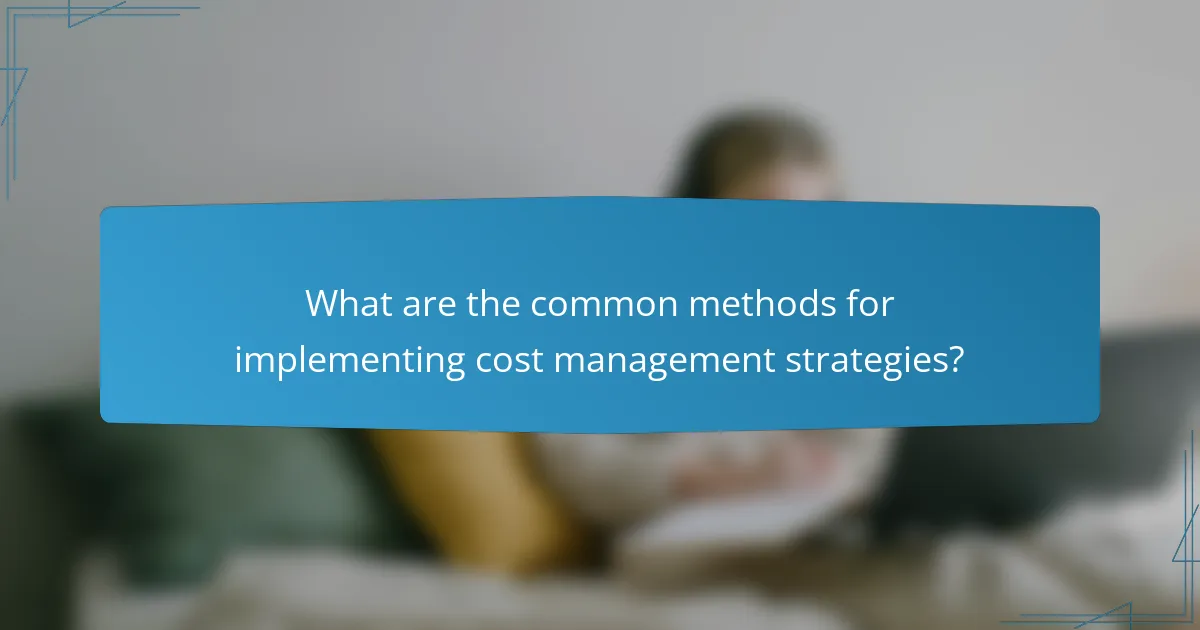Effective cost management is essential in business economics research, involving strategies such as budget planning, cost analysis, and resource allocation. Budget planning establishes financial limits for research projects, aiding in expenditure tracking and preventing overspending. Cost analysis identifies potential savings by examining all expenses, while resource allocation ensures funds are directed to the most impactful research aspects. Implementing these strategies can significantly enhance efficiency and reduce waste, with studies indicating potential reductions in unnecessary expenses by up to 20%. Common methods include budgeting, variance analysis, and cost-benefit analysis, all aimed at optimizing financial performance and resource utilization. Best practices for effective cost management encompass establishing clear budgets, conducting regular financial analyses, implementing cost control measures, negotiating with suppliers, adopting automation technology, and providing continuous employee training.

What are the key strategies for effective cost management in business economics research?
Key strategies for effective cost management in business economics research include budget planning, cost analysis, and resource allocation. Budget planning involves setting clear financial limits for research projects. This helps in tracking expenditures and preventing overspending. Cost analysis examines all potential expenses to identify areas where savings can be made. Resource allocation ensures that funds are directed toward the most impactful aspects of the research. Implementing these strategies can enhance efficiency and reduce waste. According to a study by the National Bureau of Economic Research, effective cost management can lead to a 20% reduction in unnecessary expenses in academic research projects.
How do these strategies impact overall business performance?
Effective cost management strategies significantly enhance overall business performance. These strategies lead to reduced operational costs, which directly increases profit margins. For instance, a study by the Institute of Management Accountants found that companies implementing rigorous cost management techniques improved their profitability by up to 20%. Additionally, efficient resource allocation results in better productivity and operational efficiency. This is evidenced by a report from McKinsey & Company, which states that organizations focusing on cost management can achieve a 10-15% increase in productivity. Furthermore, these strategies foster a culture of financial discipline, leading to informed decision-making. In summary, effective cost management strategies create a foundation for sustainable growth and competitiveness in the market.
What metrics are used to measure the effectiveness of these strategies?
Key metrics used to measure the effectiveness of cost management strategies include return on investment (ROI), cost variance, and profit margin. ROI evaluates the financial return relative to the cost of the strategy. Cost variance measures the difference between budgeted and actual costs, indicating efficiency. Profit margin assesses the profitability of a company after accounting for costs. Other important metrics include cost per unit, which helps determine production efficiency, and break-even analysis, which identifies the sales volume needed to cover costs. These metrics provide a comprehensive view of how well cost management strategies are performing in a business context.
How can businesses assess their current cost management practices?
Businesses can assess their current cost management practices by conducting a comprehensive cost analysis. This involves reviewing all expenses and categorizing them into fixed and variable costs. Companies should compare their costs against industry benchmarks to identify discrepancies. Additionally, they can implement performance metrics to evaluate the efficiency of cost management strategies. Regular audits of financial statements can reveal trends and areas for improvement. Surveys and feedback from employees can also provide insights into cost-saving opportunities. According to a study by the Institute of Management Accountants, effective cost management can lead to a 10-20% reduction in unnecessary expenditures.
Why is cost management critical in business economics research?
Cost management is critical in business economics research because it ensures efficient allocation of resources. Effective cost management helps organizations maximize their profitability. It allows researchers to identify and eliminate wasteful expenditures. This leads to more accurate financial forecasting and budgeting. Cost management also supports strategic decision-making by providing clear financial insights. According to a study by the International Journal of Business Economics, organizations that implement rigorous cost management practices see a 15% increase in operational efficiency. Proper cost management enables businesses to remain competitive in fluctuating markets. Overall, it is essential for sustaining long-term growth and success.
What are the consequences of poor cost management?
Poor cost management leads to financial losses for businesses. It can result in budget overruns, which affect profitability. Companies may experience cash flow issues due to misallocated resources. This can hinder operational efficiency and growth opportunities. Poor cost management can also damage relationships with suppliers and stakeholders. Reduced competitiveness in the market often follows ineffective cost strategies. A study by the Project Management Institute found that 57% of projects fail due to poor cost control. This highlights the critical importance of effective financial oversight.
How does effective cost management contribute to research quality?
Effective cost management enhances research quality by ensuring optimal allocation of resources. It allows researchers to focus funds on critical areas, improving data collection and analysis. Efficient budgeting minimizes waste, leading to more reliable results. Studies show that projects with clear cost management frameworks have higher success rates. For instance, a report by the National Science Foundation indicates that well-managed budgets correlate with improved project outcomes. This alignment between financial oversight and research integrity fosters innovation and credibility in findings.

What are the common methods for implementing cost management strategies?
Common methods for implementing cost management strategies include budgeting, variance analysis, and cost-benefit analysis. Budgeting involves creating a financial plan that outlines expected revenues and expenditures. This method helps organizations allocate resources effectively and monitor spending. Variance analysis compares actual costs to budgeted costs. It identifies discrepancies and informs necessary adjustments to improve financial performance. Cost-benefit analysis evaluates the financial implications of decisions by comparing the expected benefits to the associated costs. This method aids in prioritizing projects and investments. Organizations often integrate these methods into their financial management systems to enhance efficiency and control costs.
How can businesses identify areas for cost reduction?
Businesses can identify areas for cost reduction by conducting a thorough analysis of their expenses. They should categorize costs into fixed and variable expenses. Analyzing historical spending data can reveal trends and potential savings. Engaging employees in cost-saving initiatives can uncover insights from different departments. Benchmarking against industry standards helps identify inefficiencies. Implementing activity-based costing provides a clearer view of resource allocation. Regular audits of financial statements can highlight areas of overspending. Utilizing technology for data analysis can streamline the identification process.
What tools and techniques can assist in cost analysis?
Cost analysis can be assisted by various tools and techniques. Common tools include spreadsheet software, such as Microsoft Excel, which allows for detailed calculations and data organization. Accounting software like QuickBooks can track expenses and revenues effectively.
Techniques such as break-even analysis help determine the point at which costs equal revenues. Activity-based costing allocates overhead costs more accurately based on actual activities.
Additionally, variance analysis compares actual costs to budgeted costs to identify discrepancies. Sensitivity analysis evaluates how changes in assumptions affect outcomes.
These tools and techniques enhance accuracy and decision-making in cost management.
How can businesses prioritize cost management initiatives?
Businesses can prioritize cost management initiatives by conducting a thorough analysis of their expenses. This involves identifying which costs are fixed and variable. Next, businesses should assess the impact of each cost on overall profitability. Prioritizing initiatives that reduce high-impact costs can lead to significant savings. Additionally, implementing performance metrics helps track the effectiveness of cost management strategies. Regular reviews of financial statements allow for timely adjustments to initiatives. Engaging employees in cost-saving ideas fosters a culture of accountability. Research shows that companies that actively manage costs can improve their profit margins by up to 20%.
What role does technology play in cost management?
Technology plays a crucial role in cost management by enhancing efficiency and accuracy. It enables organizations to automate processes, reducing labor costs and minimizing human error. Software solutions provide real-time data analytics, allowing for informed decision-making. This leads to better resource allocation and budget forecasting. According to a study by Deloitte, companies that leverage technology in cost management experience a 20% reduction in operational costs. Furthermore, cloud-based tools facilitate collaboration, driving down communication expenses. Overall, technology streamlines cost management practices, resulting in significant savings and improved financial performance.
How can software solutions improve cost tracking and reporting?
Software solutions can enhance cost tracking and reporting by automating data collection and analysis. These tools streamline the process of gathering financial information from various sources. Automation reduces human error and increases accuracy in cost reporting. Real-time data access allows for timely decision-making, improving responsiveness to financial changes. Integration with other business systems provides a comprehensive view of expenses. Dashboards and visualizations facilitate better understanding of cost data. According to a study by the Institute of Management Accountants, companies using software solutions for cost management report 30% faster financial closing times. This efficiency leads to improved financial health and strategic planning.
What emerging technologies are influencing cost management practices?
Emerging technologies significantly influence cost management practices. Key technologies include artificial intelligence (AI), blockchain, and the Internet of Things (IoT). AI enhances data analysis and forecasting accuracy, allowing businesses to optimize budgets. Blockchain improves transparency and reduces fraud in financial transactions, leading to lower costs. IoT enables real-time monitoring of resources, enhancing efficiency and reducing waste. According to a report by McKinsey, companies utilizing these technologies can reduce operational costs by up to 30%. These technologies collectively transform traditional cost management approaches, making them more efficient and data-driven.

What best practices should businesses follow for effective cost management?
Businesses should follow several best practices for effective cost management. First, they need to establish a clear budget. A well-defined budget helps track expenses and allocate resources efficiently. Second, regular financial analysis is crucial. Analyzing financial reports allows businesses to identify cost-saving opportunities. Third, implementing cost control measures is essential. These measures can include setting spending limits and monitoring variances. Fourth, businesses should prioritize supplier negotiations. Better terms with suppliers can lead to significant savings. Fifth, adopting technology for automation can reduce operational costs. Automating processes minimizes human error and increases efficiency. Lastly, continuous training for employees is vital. Educated employees can make informed decisions that contribute to cost management. These practices collectively enhance a company’s ability to manage costs effectively.
How can businesses foster a culture of cost awareness?
Businesses can foster a culture of cost awareness by implementing regular training programs on financial literacy. These programs should educate employees about the company’s financial goals and cost structures. Encouraging open communication about expenses can also promote transparency. Establishing clear metrics for cost management helps employees understand their impact on the bottom line. Additionally, recognizing and rewarding cost-saving initiatives can motivate employees to be more cost-conscious. Companies that utilize budgeting tools can provide real-time data, enhancing awareness of spending. This approach has been shown to improve overall financial performance, as evidenced by a study from the Harvard Business Review that found organizations with cost-aware cultures achieve 20% higher profitability.
What training and resources are essential for staff?
Essential training for staff includes financial management, cost analysis, and budgeting. These skills help staff understand and manage costs effectively. Resources such as software tools for budgeting and forecasting are also crucial. Access to industry reports and case studies enhances staff knowledge. Workshops and seminars on cost management strategies provide practical insights. Continuous professional development ensures staff stay updated on best practices. Research indicates that trained staff improve organizational efficiency by 20%. Investing in training and resources leads to better cost control and increased profitability.
How can leadership support cost management initiatives?
Leadership can support cost management initiatives by fostering a culture of accountability and transparency. This involves clearly communicating the importance of cost management to all employees. Leadership should set specific, measurable goals related to cost reduction. They can also provide necessary resources and training to empower teams in their cost management efforts. Regularly monitoring and reviewing financial performance helps in identifying areas for improvement. Additionally, recognizing and rewarding cost-saving initiatives encourages ongoing participation. According to a study by the Harvard Business Review, organizations with strong leadership engagement in cost management achieve 20% higher savings than those without.
What are the common challenges in cost management?
Common challenges in cost management include budget overruns, inaccurate cost estimation, and lack of stakeholder engagement. Budget overruns occur when actual expenses exceed planned budgets. According to a study by the Project Management Institute, 49% of projects experience cost overruns. Inaccurate cost estimation often arises from insufficient data or overly optimistic forecasts. This can lead to misallocation of resources. Lack of stakeholder engagement can result in miscommunication and unmet expectations. Effective cost management requires continuous monitoring and adjustment to address these challenges.
How can businesses overcome resistance to cost management changes?
Businesses can overcome resistance to cost management changes by engaging employees in the decision-making process. Involving staff fosters a sense of ownership and reduces apprehension. Clear communication about the reasons for changes helps to align employee understanding with organizational goals. Providing training and resources can ease the transition and build confidence in new practices. Establishing a feedback loop allows employees to voice concerns and suggest improvements. Recognition of employee contributions during the change process can enhance morale and encourage cooperation. Research shows that organizations with strong change management practices achieve a 70% success rate in implementing cost management initiatives.
What strategies can mitigate risks associated with cost management?
Implementing a robust budgeting process can mitigate risks associated with cost management. A well-defined budget allows organizations to allocate resources effectively and monitor expenses. Regular budget reviews help identify discrepancies early. Utilizing forecasting techniques enhances the accuracy of financial predictions. This reduces the likelihood of unexpected costs arising. Establishing clear financial metrics provides benchmarks for performance evaluation. Additionally, adopting a risk management framework enables proactive identification of potential cost overruns. Training staff on cost control measures fosters a culture of accountability. These strategies collectively strengthen financial stability and support informed decision-making.
What practical tips can enhance cost management efforts?
Implementing a budget is crucial for enhancing cost management efforts. A budget provides a clear framework for tracking expenses and revenues. Regularly reviewing this budget helps identify variances and areas for improvement. Utilizing cost-benefit analysis can also optimize spending decisions. This analysis evaluates the financial implications of various options. Establishing key performance indicators (KPIs) allows businesses to measure efficiency. KPIs offer insights into cost control and resource allocation. Encouraging team involvement in cost management fosters a culture of accountability. Engaged employees are more likely to identify cost-saving opportunities. Lastly, leveraging technology can streamline processes and reduce overhead costs. Automation and software tools can enhance financial tracking and reporting accuracy.
The main entity of this article is “Strategies for Effective Cost Management in Business Economics Research.” The article outlines essential strategies such as budget planning, cost analysis, and resource allocation that enhance efficiency and reduce waste in research projects. It discusses the impact of effective cost management on overall business performance, highlighting key metrics for measuring effectiveness and methods for assessing current practices. Additionally, the article addresses the importance of technology in cost management, common challenges faced, and best practices for fostering a culture of cost awareness within organizations.